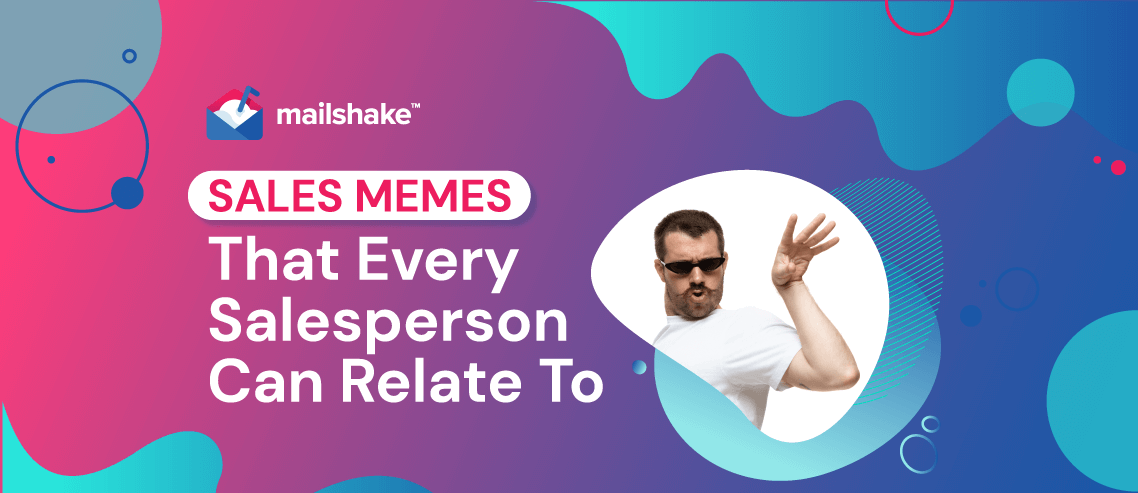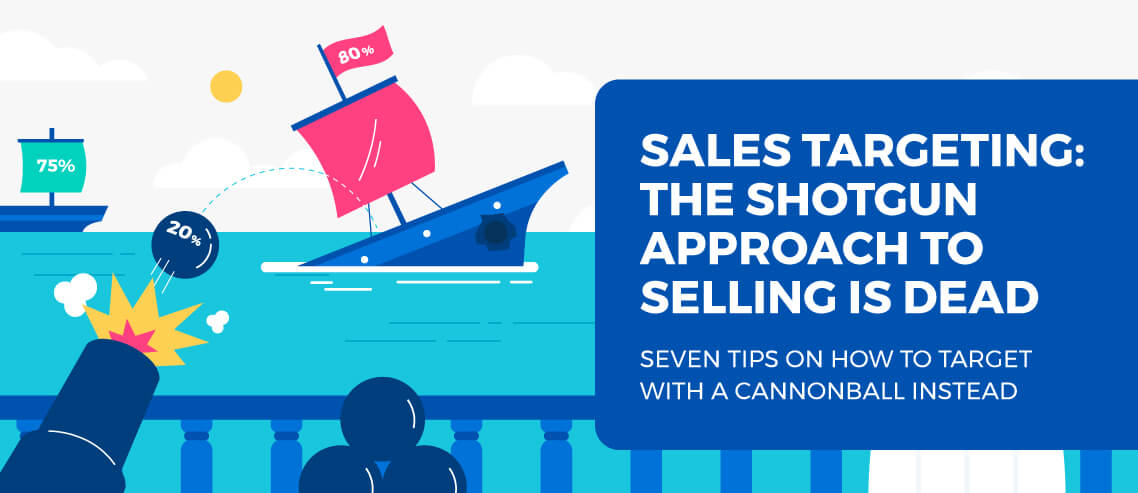29 Sales Email Templates Plus Examples

Contents
Did you know that over 319 billion emails are sent every day? In order to stand out in someone’s inbox, you have to be interesting, convincing and thoughtful – and you’ve only got a few sentences to do it.
Sounds tough, right? The truth is, it doesn’t have to be.
Most salespeople go wrong by writing emails that are too long, too self-centered and provide little or no value to the recipient. Naturally, the majority of those emails get dismissed or marked as spam the moment they arrive in the inbox. Only 24% of prospects open sales emails.
Jump-start your sales emails instantly with our proven templates
Seasoned salespeople, on the other hand, know that getting someone to open and read their email is half the battle. The other half boils down to making the email brief and to the point, jam-packing it with value and ending it in a way that provokes action.
How To Write Sales Emails That Get Responses
Here’s a simple four-line structure you can follow to write your sales emails and 29 sales email templates you can make your own.
Opening Line
Address recipients by their name, state the reason for the email and above all else, make it more about them than you. Simply put, you want prospects’ responses, and addressing the recipients by name could greatly improve your email’s response rate.
Offer Line
Scarcity is one of the best ways to get responses. You can use scarcity in your offer line by highlighting that your company does not work with just anyone or even that your product is in such high demand that there is a waiting list.
Another strong offer line can involve identifying their problem and offering a solution. To do this, highlight a pain point and try to personalize it to their situation simultaneously. The offer line can also be a great place to provide evidence and social proof in the form of statistics, case studies and exclusive content.
Closing Line
End with a short and clear call to action that can be answered with a simple “yes” or “no.” That no-friction ask makes it more likely you’ll get a response.
Signature Line
Reframe your mindset by thinking of your email signature as a personal high-converting landing page. It should contain the basics, like your name, company and contact info, but also think about what else you can add, such as social proof, rewards, links to relevant content and anything else that shows credibility and builds rapport.
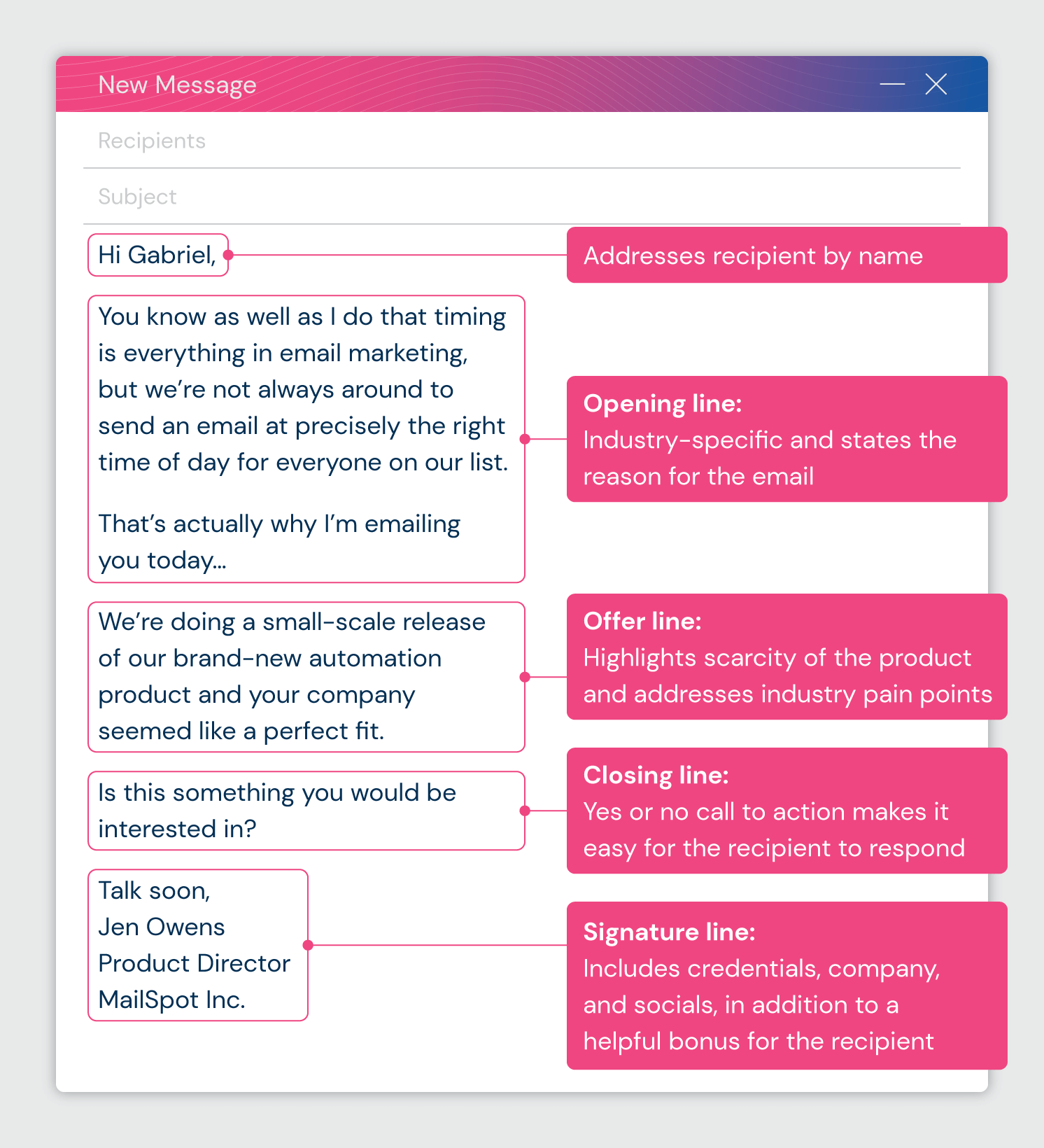
Sales Email Templates
1. The “Classic AIDA”
Hey {Name},
Could your team handle an extra 20 leads a week? I’m asking because after just two sessions with my consulting team, we’ve had other clients in {{Their industry}} see dramatic results. We’ve recently begun consulting for {{Notable person or company}} and are already seeing big results. It might sound too good to be true, but why not see for yourself? Sincerely, {{Signature}} |
Why It Works: AIDA works because it follows an effective structure borrowed from the popular sales technique:
- Attention: Seize their attention
- Interest: Explain clearly why the product or service is of value to the prospect
- Desire: Build up a desire for your product or service
- Action: End strong by outlining how they can take full advantage of the offer
Each line builds upon the last and compounds interest until prompting action. AIDA is a classic technique that works, and should be part of every salesperson’s arsenal.
You can set a goal for your team to increase average deal size and increase order value. There are different ways you can go about this, such as improving your upselling and cross-selling efforts or finding ways to incentivize bigger purchases.
2. The “Giver”
Hi {Name},
I’m researching {{Industry}} and discovered that {{Pain point}} is a major challenge in the market. Is that the case for you also? If so, I stumbled upon this {{Content}} that you might find useful. It explains how {{Pain Point}} originated and how the top performers in {{Their industry or profession}} have overcome it. I’m finding a lot of useful content and industry insights in my research lately. Would you be interested in chatting about them over coffee next week? Kind regards, {{Signature}} |
Inspired by Gabriel Swain of Agile CRM
Why It Works: Sending relevant content from your blog, industry research firms or even just book recommendations can go a long way toward building rapport and capitalizing on the principle of reciprocity. This sales email template works best if you pair it with high-quality, relevant content that is either interesting, teaches them something useful, or both. Sharing content also makes the follow-up easy since you can ask for their thoughts on that content.
3. Before-After-Bridge
Hi {Name},
For every 100 cold emails you send, you'll only get one reply. That's a lot of effort for little reward. Now imagine achieving 10X the responses in half the time. Sound too good to be true? With {Product}, you can make it a reality. Are you free for a call tomorrow at {{Give 2 possible times}} so I can explain more? {{Signature}} |
Why It Works: This is all about detailing a problem that exists in your prospect’s industry, then describing how much better things would be if that problem didn’t exist. Finally, you offer a solution – presumably something related to your product.
4. Features-Advantages-Benefits
Hi {{Name}},
{Your company} offers {Features} . It allows you {Advantages}. That means you {Benefits}. Is this something you’d be interested in? {{Signature}} |
Why It Works: Simple but effective, this copywriting formula involves detailing two or three key features of your product, explaining why they’re helpful and then detailing exactly what this means for your prospect.
5. The “5 Basic Objections”
{Product} makes it easy for you to scale and automate your email outreach. I can prove it – all I need is a five-minute phone call.
Are you free for a call tomorrow at {{Give 2 possible times}} so I can explain more?
{{Signature}}
Almost every time a prospect doesn’t buy from you, it’s because of one (or more) of these five reasons:
- They don’t have enough time
- They don’t have enough money
- It won’t work for them
- They don’t believe you
- They don’t need it
Why It Works: We’re not suggesting you should aim to overcome all of those objections every time you send an email – you’ll likely come across as overly defensive if you try to do so. But you should definitely keep them in mind when writing your email copy. If you can tackle at least one of them, then that’s one barrier to conversion out of the way.
6. The “Cliffhanger”
Hi {{Name}},
One of our clients, {Client}, used {Product} to send its latest e-book to prospects. Within 72 hours, they’d generated 500 leads. Want to know how they did it? {{Signature}} |
Why It Works: No one can resist a cliffhanger finale – it’s basically hard-coded into us to demand closure. When we don’t get it, we need to know more.
7. Write for One Person, Not Thousands
Hi {{Name}},
You’re spending too long on {Pain Point}. You wish you could do more, faster. With {Product}, you can. Our software {Features & benefits} What do you think? {{Signature}} |
Why It Works: Legendary advertiser Fairfax Cone defined superb copywriting this way: “Good advertising is written from one person to another.”
In other words, however big your potential audience is, never forget that each person who opens your emails is an individual. They have their own priorities and pain points. It’s up to you to tap into them.
The anatomy of your sales email templates boils down to making them easy to read, providing value and ending with an action-provoking question or request that’s easy to say yes to.
Sales Prospecting Email Templates
8. The “Permission Wanted”
Hey {{Name}},
I’m reaching out because I have several ideas for how you can bring in more leads and ultimately close more deals every month. Would it be OK for me to reach out next week to share those ideas with you? Best, {{Signature}} |
Why It Works: Getting permission is intriguing because nobody else does it. Doing so shows respect, builds trust, and, if done correctly, can leave someone in suspense. For instance, the email above doesn’t jump right into the product or service the salesperson is trying to pitch. Nor does it ask for a demo or a meeting. Instead, it piques interest, suggests future value, speaks to the prospect’s goals and ends with an easy ask they can respond to with a simple “yes” or “no.”
9. The “Help Me, I’m Lost”
Hi {{Name}},
I’m trying to find the best possible person to discuss {{Pain point, common industry problem}} at your company. Would you mind pointing me toward the right person and the best way to reach them? Thank you in advance for your help. Regards, {{Signature}} |
Why It Works: People inherently want to be helpful, so asking for some direction can be an easy win. When this template works as it should, you’ll also have somewhat of an internal referral when you do send that second email. You can start the next email with, “Jesse in marketing mentioned I should reach out to you to discuss [pain point].” Doing so will add credibility and increase the chances of getting a response.
10. The “Rapport Builder”
Hey {{Name}},
I noticed you and I are both members of the {Common connection }on LinkedIn, and that you just opened a new office in {City}. Since you’re a local now and share similar ideologies on clean technology and sustainability, I was curious if you’d be interested in attending our {Conference} in December. One of the keynote speakers is a world-renowned {Industry} expert. The conference starts on December 11th in {City}. Should I send you a registration form? Warm regards, {{Signature}} |
Why It Works: Pre-call discovery can work wonders for building rapport. Use websites like LinkedIn Sales Navigator to find common connections, shared experiences or similar interests. Most people are also active on some form of social media, which can be an excellent place to find out what they’re into and what you can use to break the ice and start a conversation, like this sales email template does.
11. The “Problem Solver”
Hello {Name},
I’m almost certain your {{Situation/Problem}}. Dan, our {{Product}} specialist, recently finished preparing an estimate for {{Another customer}} and found a way to reduce costs by 50%. Should I ask Dan to contact you as well? Best, {{Signature}} |
Inspired by Dan Murphy at Culture Amp
Why It Works: Showcasing a relevant problem, sharing a relevant success story and making a simple offer cuts right to the chase, which can be a refreshing change of pace.
12. The “Friend of a Friend”
During lunch yesterday with {{Mutual connection’s name}}, he mentioned you were looking to {Accomplish specific goal}}, and it just so happens my company specializes in {{Achieving specific goal}}.
He thought it might be mutually beneficial for us to connect since I recently helped {{Happy customer}} improve their {{Goal related metric}} by implementing our {{Service, software, etc.}}.
If you’re interested in discussing this more, would you be open to a short call on Wednesday at 10 a.m.?
Cheers,
{{Signature}}
Inspired by Forster Perelsztejn
Why It Works: A sales email template that highlights a mutual connection can help lower the recipient’s guard more quickly than normal, and possibly win you credibility right off the bat. It’s worth noting that the first sentence about sharing a meal really packs a punch because it shows you aren’t just a random acquaintance leveraging their name. Instead, you’ve provided proof of said relationship, and the email itself comes off more like a partnership than a sales pitch.
13. ACCA
Every time you write a cold email, you should have a clear target action in mind. Never make the reader second-guess how you want them to proceed. The ACCA formula is a great tool for this because it’s super actionable. ACCA stands for:
- Awareness: Outline the situation or problem
- Comprehension: Explain how it affects your prospect and how you have the solution
- Conviction: Create a desire for the solution you’re offering
- Action: Call to action
Here’s how to put this formula to work:
Hi {{Name}},
Firing out emails only to not receiving a response can be disheartening. That’s why thousands of salespeople are using {Product} to personalize cold emails at scale. Want to find out how we can save you time on email outreach? Let me know if you’re free for a call tomorrow at {{Give 2 possible times}} so we can discuss this further. {{Signature}} |
14. The “So What?”
Kids would make brilliant cold emailers. Why? Because they’re always asking, “So what?”
Every time you write a sentence, ask yourself the same question. In other words, why would the recipient care about the thing you’ve written? It’ll keep your copy punchy and actionable.
Here’s the difference this practice can make:
Hi {{Name}},
{Product} makes it easy for you to scale and automate your email outreach. It saves you time. And it makes your emails personalized, which generates more responses. Are you free for a call tomorrow at {{Give 2 possible times}} so I can explain more? {{Signature}} |
15. The “String of Pearls”
Right now, brands are obsessed with storytelling. But this isn’t some airy marketing buzzword; crafting compelling stories gets real results.
That’s what the “String of Pearls” formula is all about – weaving together two or three persuasive examples of your product in action to create one attention-grabbing email.
Here’s an example:
Hi {{Name}},
Sales professionals like you are using {Product} to send better emails. We helped {Customer} generate 500 emails in 72 hours. We helped {Customer} achieve a 72% response rate on cold emails. And we can do the same for you. Are you free for a call tomorrow at {{Give 2 possible times}} so I can explain more? {{Signature}} |
16. Be Specific (But Give Nothing Away)
Similar to the “Cliffhanger” technique, this copywriting formula is all about teasing the reader into learning more. Give them a tantalizing line of copy that goes into specifics while still allowing you to keep your cards close to your chest. It’s not easy to do, but it works.
Here’s how it looks in action:
Hi {{Name}},
We’re {Company}, and we supercharge cold email outreach. Our clients are achieving cold email response rates of 72%. Sounds good, right? Are you free for a call tomorrow at {{Give 2 possible times}} so I can explain more about what we do? {{Signature}} |
17. The OATH Formula
Another kick-ass method to keep your cold emails laser-focused is to consider the four stages of audience awareness:
- Oblivious: Completely unaware of you
- Apathetic: Aware of you, but disinterested
- Thinking: Potentially interested in what you have to say
- Hurting: In desperate need of a solution that you can offer
Figure out which of these four stages your prospect falls into and use this insight to hone your copy.
Here’s an example targeting the “oblivious” stage:
Hi {{Name}},
We’re {{Company}}. You might not have heard of us, but we help people like you craft personalized emails faster. Less time. Higher response rates. More sales. Are you free for a call tomorrow at {{Give 2 possible times}} to discuss how {{Company}} can help you? {{Signature}} |
18. The “Cut the B.S.”
Who doesn’t appreciate it when a salesperson gets directly to the point? This copywriting technique skips through the “carefully crafted story” and mountain of statistics and explains to the recipient exactly what they need to hear about you and your offering. Time is a valuable resource, after all.
I’m {name} from {Company}. Let me get to the point because I know you’re busy.
Our {Product} can help your team increase your sales by {service}. Most of our clients spend only {cost} for this service.
Let’s jump on a call tomorrow at {{Give 2 possible times}} and I’ll give you the details.
{{Signature}}
19. The Ed McLean Technique
The late Ed McLean was objectively one of the greatest copywriters of all time. His epic Newsweek mail-out remained the control for over 15 years and reached over 150 million people throughout that time.
The technique focuses heavily on conversational messaging and honest copy. It helps readers feel at ease, and more importantly, compels them to buy whatever you are selling.
Here’s how you can mimic his style:
Hi {{Name}},
I’m mailing you today because I think our {Product} can be of great value to you and your team. Now, let me be frank. This isn’t a magic wand. It won’t increase your sales by 1,000% overnight. And it certainly won’t solve all of your problems forever. How can {Product} help, then? Our {Product} will give you and your team the tools you need to make your business better. That’s about it. But a great team like yours, armed with all the right tools, can only lead to one thing: success. I understand if you’re not sold just yet… So let me make you this offer: Hop on a call with me tomorrow at {{Give 2 possible times}}. If, after the call, you feel as though I’ve wasted your time, I’ll send you a voucher for a free coffee and then you’ll never hear from me again. {{Signature}} |
20. Get Vulnerable
Sharing experiences helps build connections with one another, and what is sales if not building a connection with a buyer?
By showing your own vulnerability, acknowledging a common problem and how you solved it, you can build more than just a sale with a potential customer – you can build a lasting relationship.
Here’s how you can use vulnerability in your email:
Hey {{Name}},
You know what terrifies me? Project management. Checklists genuinely overwhelm me. I never know where to even start. Our resources can help you and your team feel more equipped and more confident to manage projects effectively. How do I know this? Because they’ve helped me. From organizing my contacts to streamlining my team’s processes, {Product} has been a lifesaver. Not only has our team become more efficient, but we’ve also increased our margins – in a big way. It may sound silly, but being organized is a huge confidence builder, and more importantly, a huge money saver. Want to give it a try? {{Signature}} |
21. The “Us Against the World”
This technique can make the recipient feel like they’re part of a special club, like you share a secret that no one else knows.
Be forewarned: This approach works best when you know your recipient. Being able to identify their problem will help you present a solution in a way that will make them feel like it was their idea to work together all along.
Here’s how to make your prospect feel like they’re part of a special club:
Hey {{Name}},
I’m reaching out to a small number of project managers and team leaders like you because I wanted to share something that we think is truly special. {Product} is a game-changer for {industry}, but it’s definitely not for everyone. It’s geared toward experienced professionals who actually enjoy diving deep into the data side of our business. I’m trying to pass out these invites quickly, so let me know if you’d be interested! {{Signature}} |
22. Overdeliver Right off the Bat
Listen, everyone likes free stuff. And if that stuff adds value to their life, that’s even better.
There’s no better way to draw a customer in and highlight how special your product is than by simply giving them a taste. Whether it’s a report, case study, demo or even a free trial of your product, you can rest assured that your communiqué will not go unnoticed.
Here’s how you can use freebies to your advantage:
Hey {{Name}},
We’ve just put together an exhaustive case study that I think you and your team will find valuable. We spent $1 million on Facebook ads, and this is what we learned: Click here to download the case study for free. Let me tell you…there was one common annoyance throughout the process and I’m willing to bet it’s something you’ve run into as well. Save my email address – I think you’ll want to send me a message after you’ve checked out this report! {{Signature}} |
Bonus Template
Hi {Name},
You recently visited our website and downloaded {Content}. Did you find it useful?
Did you download the piece just to learn more about {Content Topic}? Or, are you looking for a cost-effective solution to {Content Topic}?
I actually did some research on {Their company} and have the following tips:
{Relevant tip}
{Relevant tip}
Have you thought of doing this?
Best, {{Signature}}
——
Inspired by HubSpot Sales Email Template Builder
Why It Works: If you happen to offer site visitors downloadable goodies, like a particular case study or e-book, you can use that information to spark up a conversation and find out more about what made prospects download your document — it hints at their pain points. Plus, this template shows you took the time to research the prospect in question to offer personalized advice. It gives your message a more personal touch, while the simple “yes” or “no” closing line makes it more likely to get a response.
Follow-up Email Templates
People are busy. You’re not always going to get a response right away. In fact, you should probably expect to send a few emails before getting a bite. That’s just how it goes!
Did you know that 92% of salespeople give up after four “nos,” but 80% of prospects say “no” four times before they say “yes”? Follow-up emails are absolutely essential in driving sales, especially with cold leads.
But how do you send an effective follow-up email?
The most important thing to remember is that you need to remind them exactly who you are and what you’re trying to help them fix.
Here’s how to follow up the right way:
23. Polite and Straightforward
Honestly, sometimes people just forget. Especially when you’re not yet part of their contact list. Don’t fret – just be polite and straightforward.
Hey {{Name}},
I wanted to make sure you didn’t have any questions regarding my previous email about how our {Product} could help save your team some time on their next big project. How's Thursday or Friday for a quick Zoom call? I'd be more than happy to set something up for us if you're interested – just let me know a good time. {{Signature}} |
24. The “Gentle Push”
The “gentle push” can be a lighthearted, personal and even funny way to get a response from your prospects.
Companies receive tons of emails every day, but sometimes all it takes is a little personality to snag a new client.
Welp, you haven’t responded to my previous email, which tells me one of three things:
1) You’re not interested and I should stop bothering you
2) You’re interested but don’t have time
3) You’ve given up on technology and moved to the Alaskan wilderness
Listen, I feel you in all three scenarios. Not a day goes by when I do not think of fleeing into the wilderness myself.
Do me a favor, though: If you are interested, reply with a #2 so I know to follow up again.
{{Signature}}
25. Add More Value
It’s simple: Freebies rule. As they say, never underestimate the effectiveness of a straight cash bribe.
Hey {{Name}},
Was thinking about you earlier and I thought you might find this report helpful: Free report It kind of touches on my previous email in which I discussed how {Product} completely transformed my team’s productivity. Let me know if you have a second to jump on a call in the next couple of days to discuss it! {{Signature}} |
Email Template for New Clients
You’ve scored a new client; now what? You’ll need to nurture that lead and help them realize how valuable you can be for their business.
26. Introduce Yourself and Your Business
They’ve already engaged, which means they’re interested in your brand. Now it’s time to make them feel welcome.
Take a second to introduce yourself and let them know a little bit about your business.
Hey {{Name}},
I’m {name}, a {your role} for {your business}. We created {company name} in order to {mission}. If you have any questions or comments about how we do things or our products, please do not hesitate to reach out to me! {{Signature}} |
27. The “Proposal”
This is an email that you would want to send after the prospect has already had some correspondence with you and your brand: Your sales proposal.
A good sales proposal will have three elements. It will identify their problem, introduce your solution and highlight the features and benefits of your product.
Hey {{Name}},
It’s me again. I remember that you were a project manager. Let me ask you a question… Have you ever felt like the path to your goal lacked a clear direction? Or that your team was struggling to come together? I think we can help. {Product} was built to give structure to even the most complex of projects. The {feature} will give you and your team the tools you need to come together and tackle the project efficiently and effectively. This will help save on your overhead costs and get your amazing product into the hands of your customers even faster than you are now. Want to jump on a call tomorrow to talk about it? {{Signature}} |
Email Template for Existing Customers
Some businesses forget how important returning customers can be. In fact, they’re not only likely to spend more, but they may even become advocates for your product!
28. Send a Survey
A simple follow-up after a purchase is a great way to keep a customer engaged. It may seem like a no-brainer to some, but a simple check-in to say thank you and make sure they actually enjoyed the product you sold them can go a long way.
Not only will this help put your company’s name back at the top of their inbox, but it can also help you gather some valuable information about your product.
Just checking in! Wanted to say thank you once again for your purchase and ask if you had any feedback for us.
Your input is vital in ensuring that our products are meeting your needs – a mission we take very seriously.
{{Signature}}
29. Freebie for a Loyal Customer
You’ve already provided value, so why not add some more? Giving a freebie is a great way to keep your customers engaged. It can also create an opportunity for you to introduce them to a new product.
Say you send a free report showcasing the benefits of email outreach. Introduce them to your automated email outreach software while you’re at it!
Hi {{Name}},
We’ve just released a new report that I think will be right up your alley. Check it out here It’s a deep dive into a problem I think we’ve both experienced. In fact, it’s why we created {Product}. Have you had a chance to try it out? {{Signature}} |
How To Personalize Your Outreach at Scale
While most sales emails don’t need to be hyper-personalized, there are some mistakes you should avoid. Some of the things consumers find most frustrating are:
- Recommending products that do not match their interests
- Including expired offers
- Misspelling their name
Staying ahead of these common mistakes is pretty straightforward. Here is an easy formula to follow when deciding how to personalize your emails:
- Send different emails for different targets and different products
- Research individuals and personalize the first sentence
- Make sure your offer is still valid
- Double-check that you spelled their name correctly!
For instance, at Mailshake, two groups that we target are salespeople within sales teams, and consultants doing their own prospecting.
Obviously, these two groups have different characteristics and pain points, so emails to both will be different.
On an individual level, though, a sales representative can take five minutes per prospect, check their LinkedIn, website, and other social accounts. From there, they would find an angle that encourages them to open the email that connects to their offer and shows that this isn’t the exact same email that’s being sent to hundreds of other people.
With Mailshake, you can:
- Personalize email outreach with mail merge
- Create and schedule automated follow-ups
- Manage leads generated from your campaigns
- Integrate the rest of your tech stack for added efficiency
Bottom line: Personalizing is absolutely essential to an effective outreach strategy, but it’s only one piece of the puzzle, and there’s no reason why you can’t automate it.
Sales Email Examples
Want to see these sales emails in action? Check out these 11 examples:
The “Rapport Builder”
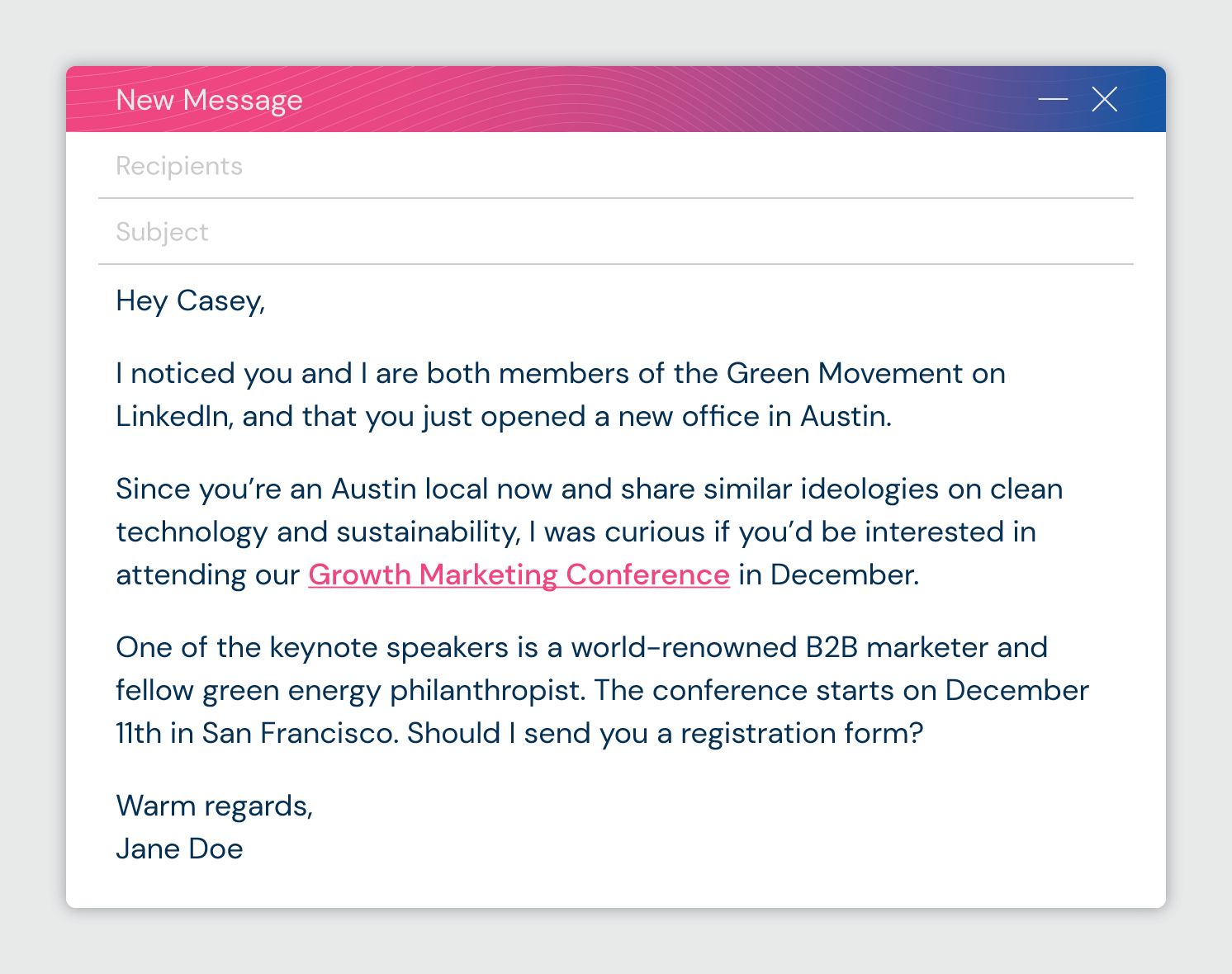
Why it works: The sales rep has used the “rapport builder” structure. This demonstrates that not only are there several mutual connections and commonalities between the two organizations, but that they have done plenty of research ahead of the email. She then closes by positing a solutions-focused business relationship, rather than a product relationship, making a very strong case for a response.
The “Giver”
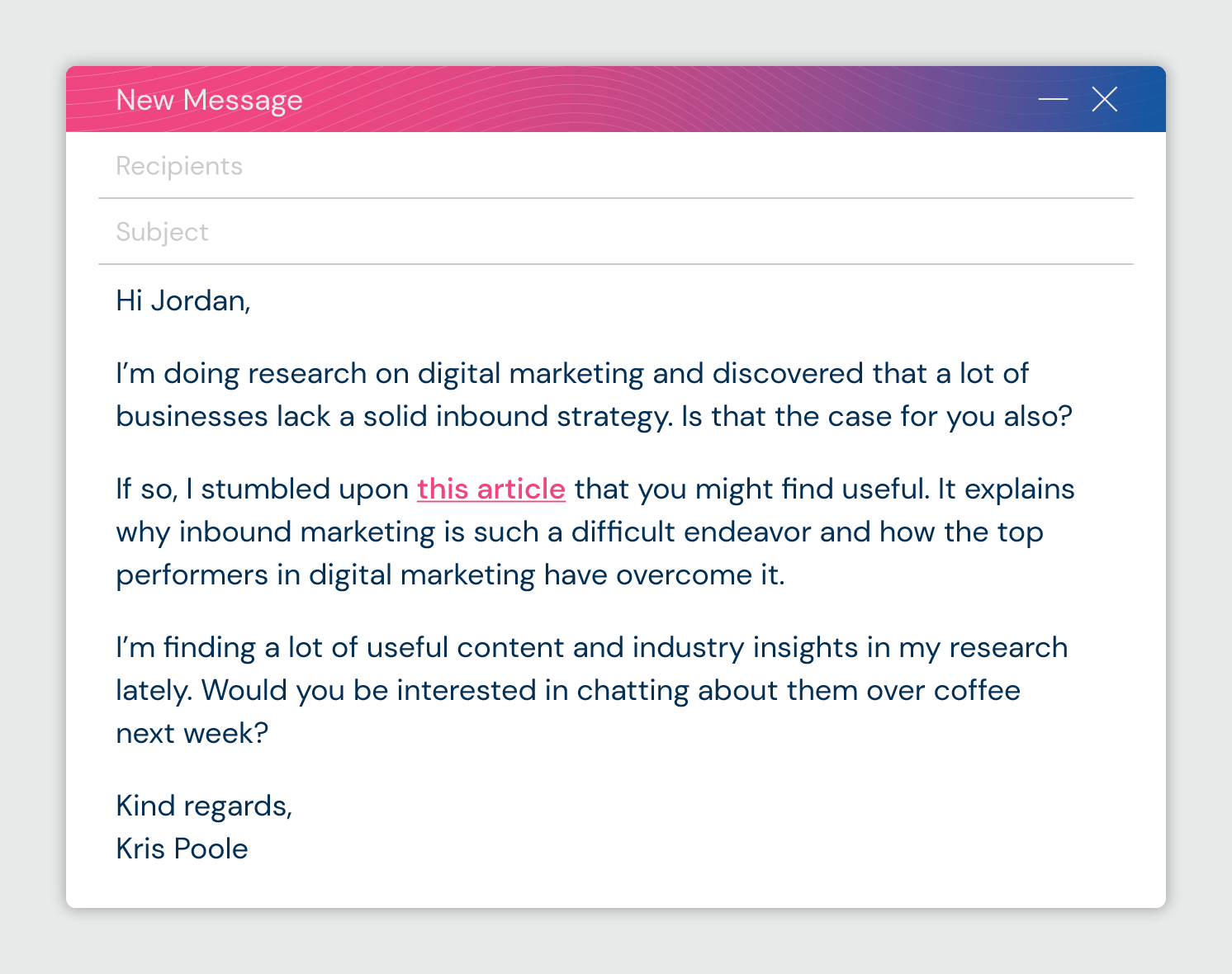
Why it works: The sales rep begins by complimenting HubSpot’s brand, and solidifies this by linking to a recent article he liked. This is a useful way to personalize cold emails. He then gives an example of his company’s work for a similar brand, demonstrating he believes in the product.
The “Friend of a Friend”
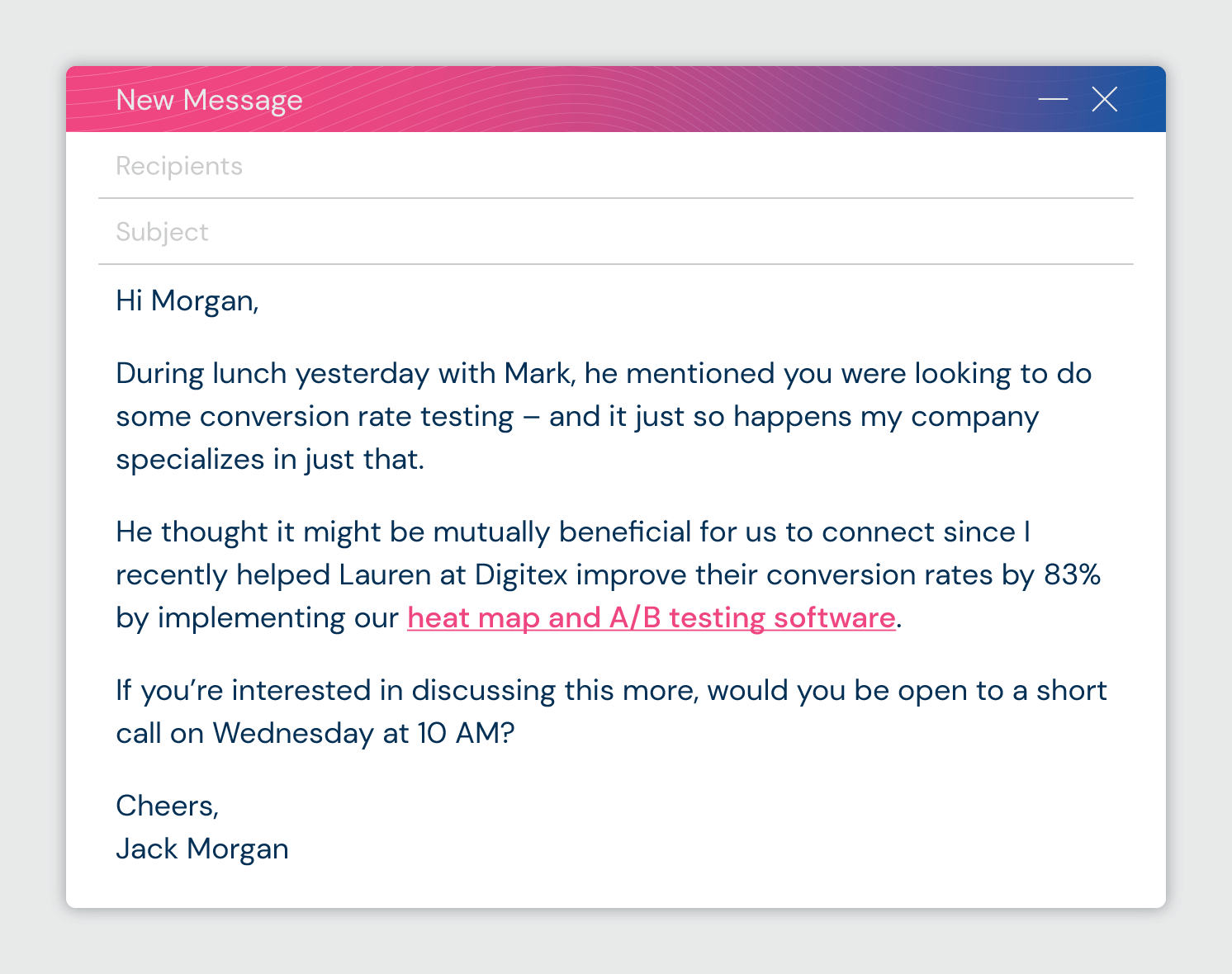
Why it works: This is a simple example of the “friend of a friend” approach. The sales rep highlights this mutual connection right away before deftly outlining what service they are offering, and finishes up by giving the prospect a personalized video.
Cold Email Examples
The Ed McLean Technique

Why it works: In this sales letter, Ed McLean is casual, engaging and downright charming. Even though this letter is 63 years old, it still draws you in and makes you want to know more about whatever he is selling. The conversational style and honest copy are what sets it apart from so many others, and that carries a lot of value in the sales industry.
The “Us Against the World”
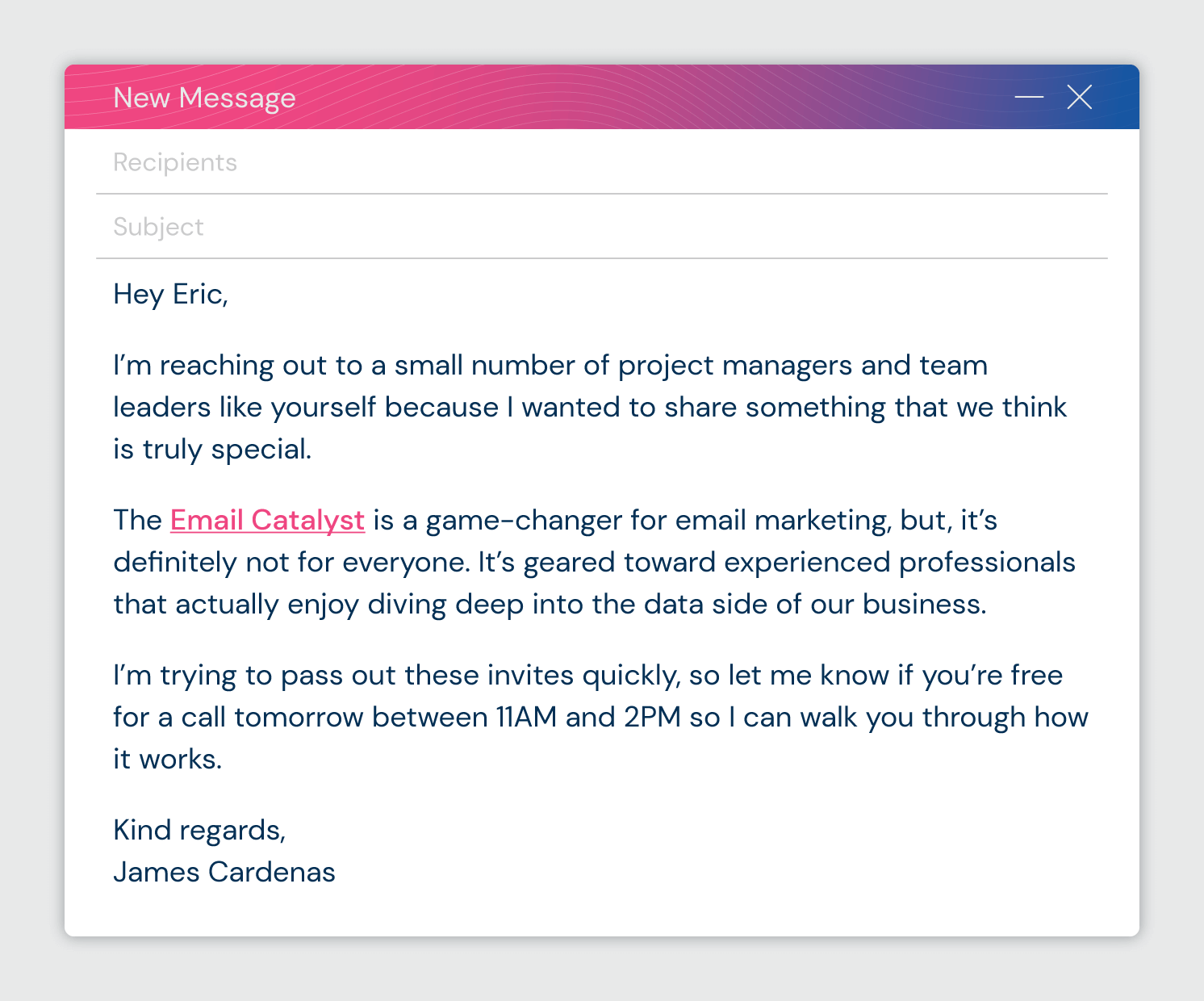
Why it works: This piece is loaded with prime examples of engaging copy. The sales rep knows exactly who they’re targeting and hones in on them right off the bat. Not only does it make the recipient feel like they’re part of an elite club, but it also squeezes in a freebie to boot.
Follow-up Email Examples
The “Gentle Push”
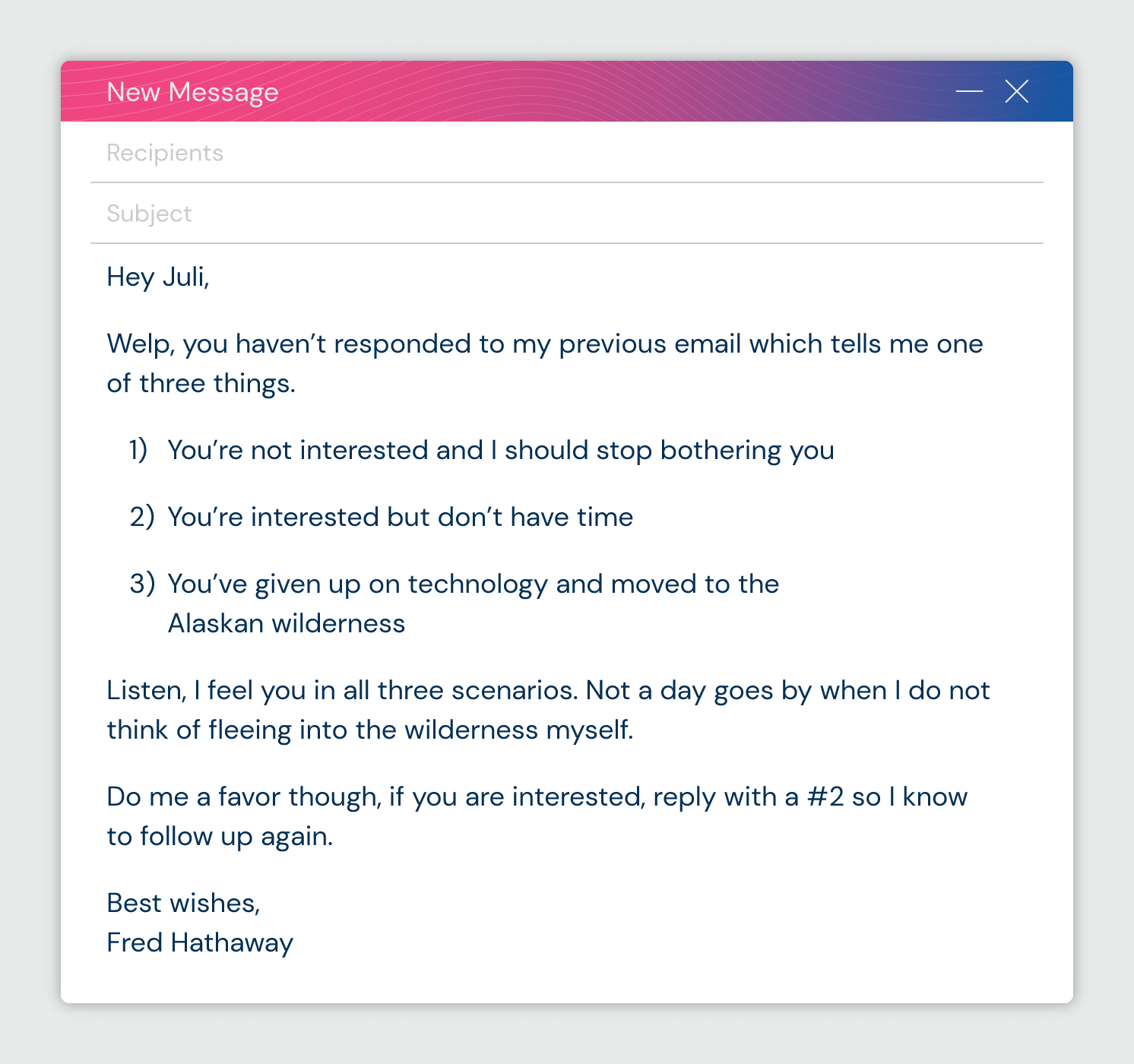
Why it works: This email is a perfect example of how to use humor to keep your name at the top of a prospect’s inbox. It gives the recipient a little comic relief in their workday while still reminding them that you have an awesome product that can help them solve a problem.
Add Value
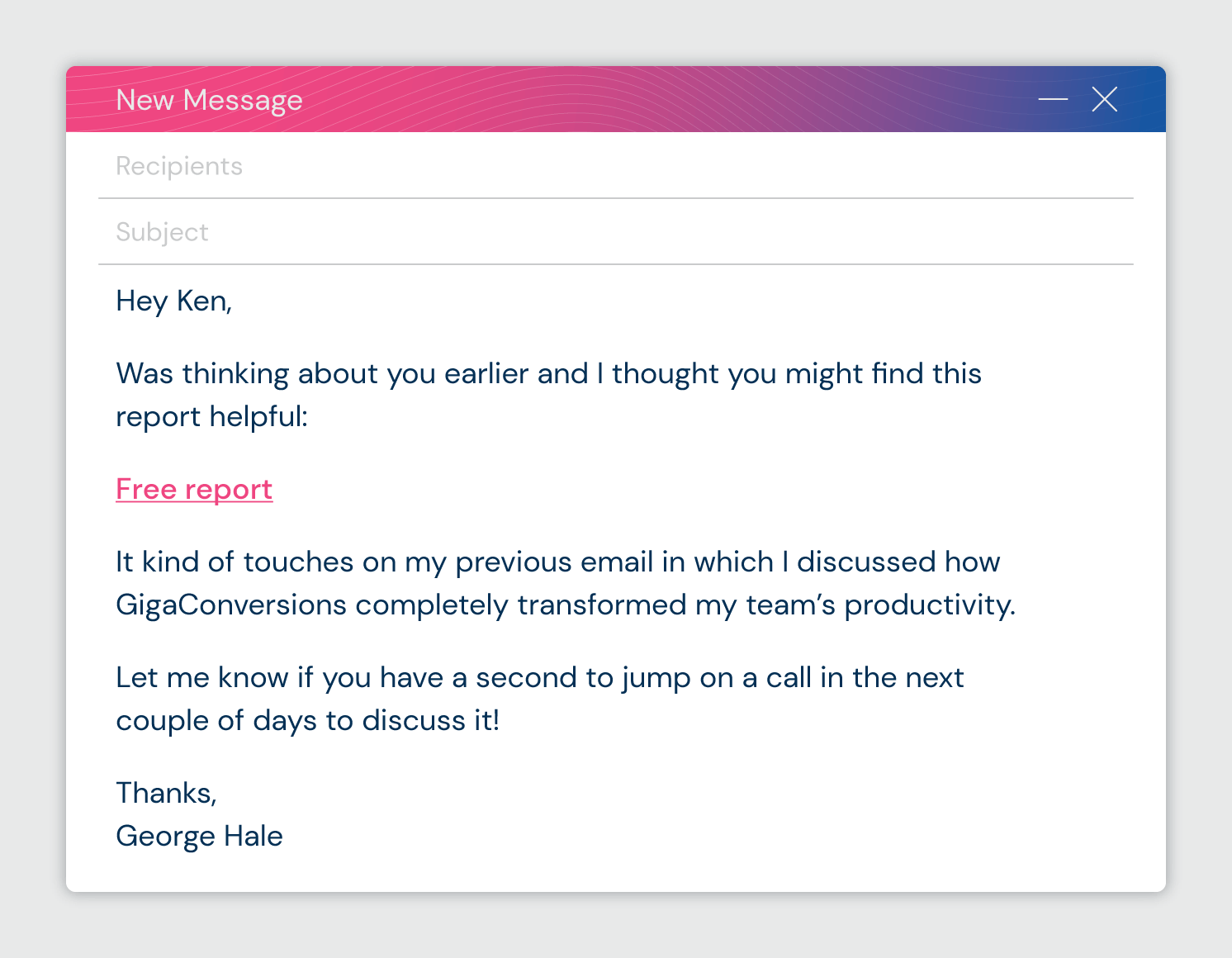
Why it works: In this email, the sales rep is following up with a customer who already attended a conference of theirs, and they even throw in a free report. This will keep the customer coming back by reminding them exactly how valuable Salesforce’s insights were for their business.
New Client Email Example
Scoring a new client is just the beginning of your email strategy. Once you’ve got an interested buyer, you’ll have to keep them engaged!
Here are some examples of how you can keep your new client opening your emails:
Introduce Your Business
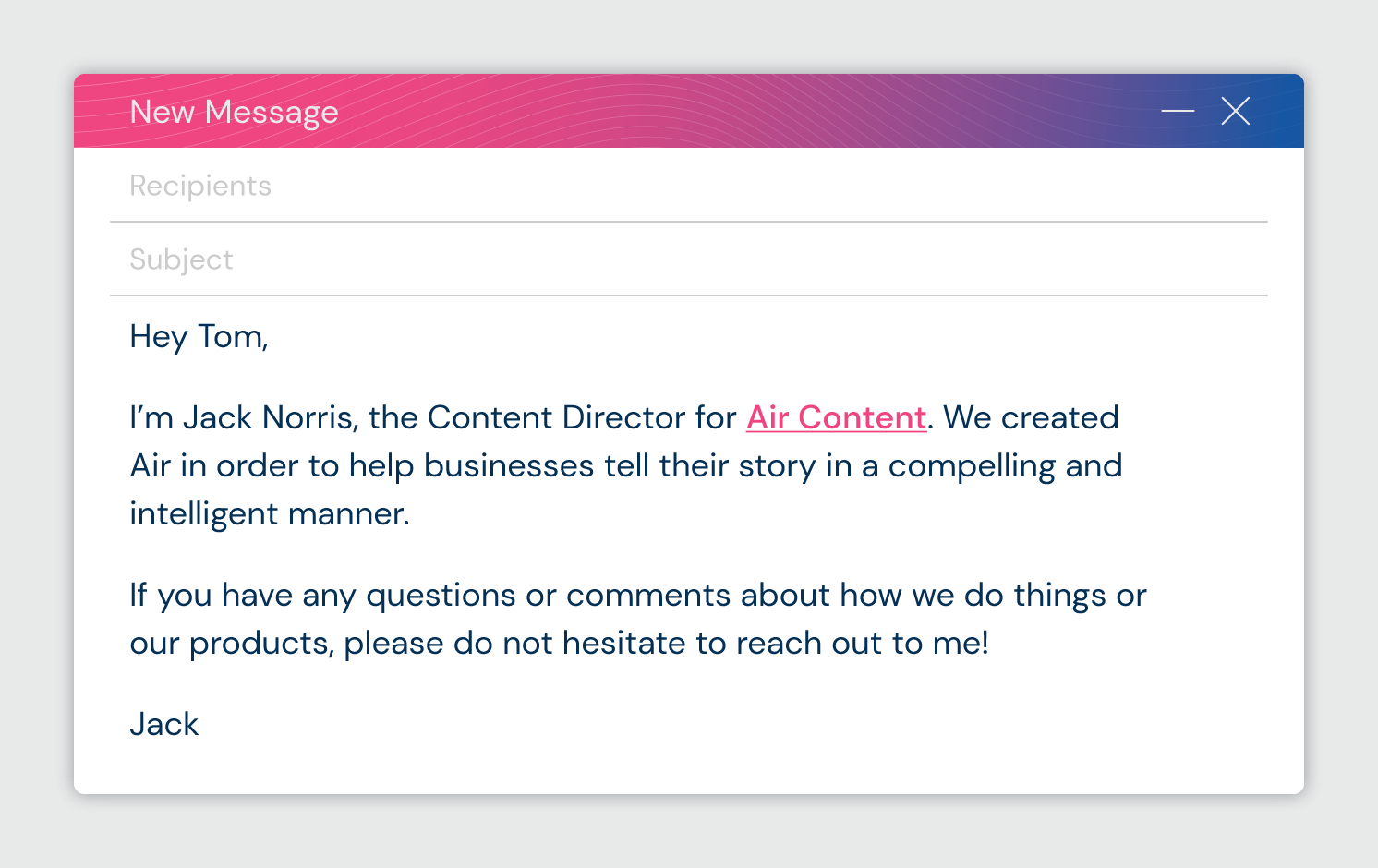
Why it works: This sales rep knows exactly what the customer is looking for: They want to discover new music. In addition to giving the customer a quick intro of what they have to offer, they include an easy call to action.
Existing Client Email Example
Now that your new client has made a purchase or two, it may be worth getting some feedback to ensure they’re actually enjoying your product. Likewise, you can pile on some extra value or offer a new product to keep them engaged. Remember, clients who have already made a purchase are the most likely to buy a new product as well.
Here are a few examples that can help you keep existing clients engaged:
Send a Survey

Why it works: The rep keeps it short and sweet. He introduces himself and then asks for feedback, with a promise that the survey would take less than a minute. It’s an easy win for Slack as they engage the customer and gain valuable insight.
Improve Your Deliverability
Now that you have an idea of what you need to do to send emails that convert, you may consider optimizing your email deliverability.
Did you know that as much as 25% of sales emails sent never reach their destination? Whether your email is one of the 75% that make it to the recipient depends on a number of factors. From verbiage to links and more, keeping your images clean and not too ‘salesy’ can greatly improve deliverability. Keeping your list scrubbed and active can help, as well.
Scale Your Email Outreach Today
Remember that the greatest results will come from trying out different templates, keeping what works, ditching what doesn’t and continually tweaking until you’ve developed the perfect sales email template for your business.
Sending sales emails is a game of persistence. You won’t find success overnight, but with the right template, you can deliver substantial benefits to your business in no time.
But that’s just the beginning.
Armed with a strong set of sales templates and a newfound love for copywriting, your team is ready to start selling en masse. Set up a demo with Mailshake today and learn how you can use automation to help your team send interesting, convincing and thoughtful emails at scale.



